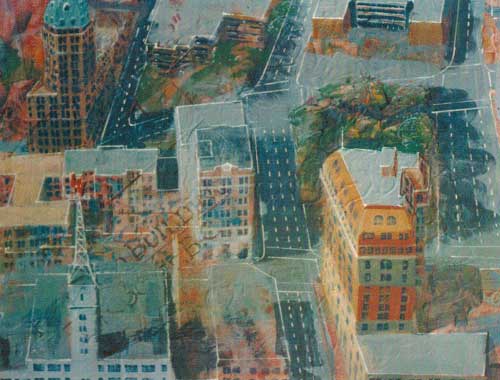Click here to download PDF PORTFOLIO IDEAS
Portfolio Suggestions: The application process for design schools can seem to be a mysterious process. It’s a competition – take it seriously, but don’t be reluctant to do it if it’s what you want. They want to find out if you are mature enough, prepared enough and will be interesting enough to have around for several years, compared to the other candidates. The best candidates will make the best students, the best studio colleagues for other students, the best graduates, and will often bring the school the best reputation as professionals down the road. So, you see, it’s not about WHAT YOU WANT – It’s about WHAT YOU CONTRIBUTE or “what you bring to the party”. Keep that in mind as you write your letter of intent. This is a set of totally unofficial personal observations from some previous experiences as a portfolio evaluator for another design school, not the one you are applying for. CHECK SPECIFIC REQUIREMENTS FOR THE SPECIFIC SCHOOL YOU ARE APPLYING TO – THEY ARE ALL DIFFERENT!
These are some suggestions for addressing many of the criteria for entrance into a design program where entry is competitive and where a portfolio review and/or interview is required. It is for built environment design, but could be applicable to other types of design programs also. The ‘evidence’ items are only examples. Few people could actually fill every space below, but if you have areas of ‘deficiency’ these suggestions may start you thinking about how to remedy them. Nothing is guaranteed, however, and much depends on the nature of your competition from other applicants that year. Problem-solving and creativity have a higher ‘weighting’ generally than the other criteria. Visual literacy, drawing skills. awareness of the profession ,craftsmanship and life-skills would be next in value. Digital, written and oral language would be less weighted, though still necessary. Organize the portfolio clearly according to the criteria from the specific School. Make everything orderly and obvious…don’t make evaluators hunt for relevant info. Prove with physical, tangible evidence that you have met each criteria. A mere statement is not enough. Make your portfolio sing and APPLY. Get feedback, then refine it and APPLY again!
First of all –If they have an Open House, GO TO IT! Talk to presenter/instructors – Wear a nametag! Then APPLY – Even if you don’t quite feel ready this year apply anyway and go through the process. The fact is, depending on the competition, you might make it and save a year, or at least you will have valuable feedback – be insistent about getting feedback.. People who just go away and work to remedy self-assessed shortfalls are not guaranteed entrance. Applicants who are turned down may get some credit for perseverance and commitment, but only if they did some serious work to improve their work and submission. Depending on the school or program, 20-30% of candidates may be resubmissions. Being turned down the first time can be advantageous as it gives you time to target and acquire the skills necessary to cope with the program and benefit, instead of struggling through. Evaluators are careful because if a poorly prepared or uncommitted person drops out after a year, there is an empty space that continues through the 3-4 years that could have been filled by a stronger or more committed candidate. Politely request specific feedback if rejected – do it right away, don’t wait. Some programs do this as a matter of practice, some do it only if requested, some don’t do it at all – but ASK for it without delay, twice if necessary. Don’t be too obnoxious about it, but a generic form letter from them is useless. Schools put people through a lot of trouble applying, so you are certainly at least entitled to ask for that consideration.
All typing and portfolio itself should be clean and professional. A good size/format is 11 x 17. Make the images large and clean within the format.- use photoshop or equal. Each criterion below should form a section in the portfolio with a brief written description plus the ‘evidence’ pieces. The sections should be clearly labeled and separable so several evaluators can look at sections at the same time, but should obviously belong to the same package. Have unity and emphasis…ie. one section is larger/special. Think about how to lay the portfolio out on a tabletop to make a display. Show numerous quick sketches. Engage the senses…sight, sound, touch, smell. Use interesting but clear graphic layout…ask a graphic designer friend to help or critique. Use three levels of type – headers, subtext, body text….adequate but minimal writing. Think about “Branding” – Who are you and how are you different from other candidates? Evaluators might say, ”Let’s have another look at the dancer, the musician, the business person”. They will seldom say, “Let’s have another look at that person who was pretty much like everyone else”. How can you show your ‘brand’, who you are, in your portfolio? How about adding a “Me” page?
If there is an oral interview be ready to verbally discuss and explain things such as: “Why sample X in your portfolio is ‘creative’. What does ‘Creativity’ mean? Why do you want to be a designer? What are your strong points? What are your weak points? Who is your favourite designer and why? What is one example of good design and why? Any designers/builders among family or friends? Name a registered professional designer you know personally. Connect through local Architectural Association website. Interview at least one registered professional designer in your area of interest and have a little questionnaire about what they like or dislike about working as a designer; what do people usually make after 2yrs, 5yrs, 10yrs.; would they recommend their job to a young person; would they do it again themselves? Remember their name and some projects.” Think about these questions and even write out the answers in prep for an interview so you are relaxed and thorough.
Take a public speaking course and also add evidence of this to your life-skills portfolio section. They want to know that you are mature and thoughtful about what design really is and that you are realistic about what the work-life of a designer will be like. It is in large part about very hard and detailed work and RESPONSIBILITY for other people’s money. It is a SERVICE job, different from fine art, which is more about YOU as an artist, by comparison. It might seem like a lot of work, but investing the years and $$thousands to enter a profession for a lifetime without doing these things to become aware of the realities is just plain foolish. Good luck!
Suggested Examples of Evidence:
This non-specific example table may help you to think outside the box when creating your portfolio and written submission. Did you study jazz dance, rock climb, teach in Borneo? (No kidding – google “architecture and jazz dance”.) Everything relates to design – be able to explain how your interest/experience does so – eg ‘heightened awareness of the human form moving through space’! Make it tangible – show photos. Remember, adjudicators are evaluating you as a potential colleague who they and your fellow students will have to work with for several years. The portfolio is more than just a collection of objects in a folder. It’s EVIDENCE of your readiness, uniqueness, ability to contribute in a studio group and likelihood of success during and beyond the program. Evaluators may use a score sheet similar to this (Partly adapted from a scoresheet for Interior Design at Kwantlen Polytechnical University):
| Sample Criteria |
Evidence suggestions/examples |
Scoring and Comments Minimal/Adequate/Outstanding |
| Problem Solving:Ability to articulate and define problems. Depict, propose and execute solutions. Organized and integrated. |
Drafted plan of room/furniturePhotos of finished projectplans and details for shelvingphotos of completed shelving |
-socially aware, worked as a volunteer for CNIB and designed an apartment for a -blind person-designed a shelving system |
| Creativity / Originality:Innovative, unexpected, thought provoking |
course outline and fee receiptsketches in sketchbookphotos of self in performance |
took a course in ‘lateral thinking’designed pieces of furniturestudied dance, mime, acting |
| Drawing Freehand |
sketchbook (should be full !)course certificate and samples |
sketches of 50 – 100 objectstook perspective sketch class |
| Drawing Technical– measured drafting |
sample sheets of hand or computer draftingcertificate of completion |
plan/section/elevation and details of own house drawn to scalebasic night school drafting course |
| Visual Literacy:range, understanding, 2D and 3D |
paintings . lots of object sketchesphotos of sculptures in various lighting, creative photog. Etc. |
personal artwork, still-lifeclay sculptures of human figure– just sculpt and photo – don’t cast them…this takes time. |
| Craftsmanship:level of skills, attention to detail and care in execution |
photos and/or originalsphotos and/or originals |
ceramics///hand thrown pottery on wheel, and handbuilt pieces.woodworking class samplestook digital photography course |
| Digital Literacy:variety of software and level of skills |
certificates and/or sampleshave printouts of webpages |
photoshop, msword, excel, powerpoint, autocad 1 and 2created own website |
| English Oral:clear and effective at presenting ideas and handling questions |
InterviewPublic speaking certificate |
good question responses in interview |
| English Written:Clear expression, grammar, spelling, ability to write essays, letters, etc. |
Language proficiency testing or transcripts of education in the English languageessay samples |
education in the language, toefl or similar testing,creative writing coursereport writing course |
| Awareness of Design Profession:research, level and range of understanding, amount of exploration. |
printouts from internet on registration process for the profession (not dated night before the interview)written in-person interview answers and analysis from at least 3 registered professionals in the field…NAME THEM! |
necessary but not sufficientcreate own probing questionnaire about the profession and have in-person or telephone interviews with practicing professionals |
| Life skills:resume. questionnaires, reference letters, work habits, life experience, travel, commitment, maturity, perseverance, altruism, leadership, community involvement, teamwork, organization and time management, discipline, stress management, motivation and entrepreneurship, etc. |
certificates, letters of reference, photographsphotos of buildings and gardensphotos of team |
volunteered for non-profit society worked in customer service retailoffice experiencecustomer service trainingwas high school peer counselorinteresting travel experiencesplayed on sports team and was assistant organizer.does yoga (stress relief) |

